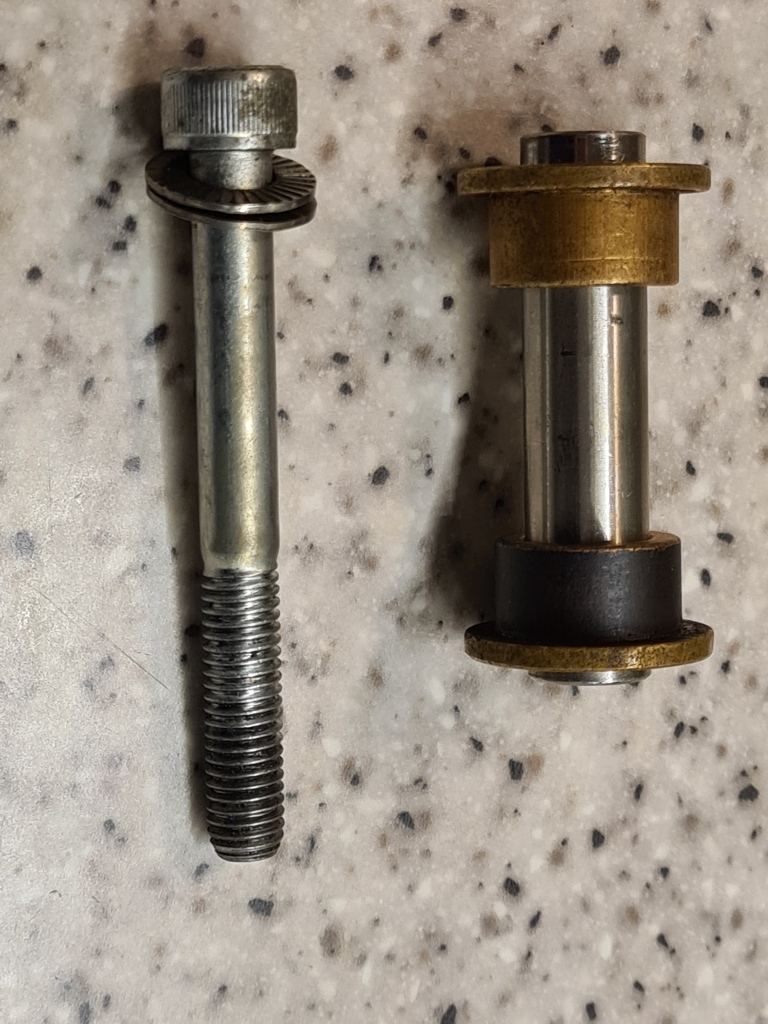Suspension on a road bike is difficult, as road bikes need to be light and need to be ridden up hills as well as down, quite fast. Nor do they need much travel, since even West Berkshire Council roads aren’t as rough as the sort of stuff mountain bikes have to cope with. Yet, scale down MTB suspension and you don’t really end up with anything lighter.
Moultons and Bromptons therefore use a very simple form of rear suspension, with a single pivot and a lump of rubber that gets squashed (Brompton) or squashed and sheared (Moulton) to provide shock absorption and some degree of inherent damping due to the hysteresis of rubber. In fact, Bromptons use it more as a method to maintain contact between main frame and rear triangle without it coming apart and clanking on bumps, which the very hard aftermarket suspension blocks do permit!
(Hysteresis, in this context, is when something returns to its original state but doesn’t return all the energy it absorbed in the first place. Something like a Super Ball has very low hysteresis and will bounce almost as high the distance it was dropped from, but rubber used in suspensions is designed to absorb far more energy, preventing the bike from bouncing more than once).
The pivot on an F-frame, TSR and a Brompton is of very similar design, with two bushes pressed into a tube in the main frame, a steel sleeve that can freely turn in the bushes, and a bolt (or bolts) to pinch the sleeve tightly between the “ears” of a rear frame assembly.
In service, the F-frame pivot gives very little trouble except being somewhat hard to overhaul. The Brompton pivot deteriorates in use but is surprisingly long-lived. The TSR pivot is a flawed design and can wear out quickly, causing poor derailleur gear indexing or noise as the rear end floats from side to side. This is especially unfortunate, since F-frame Moultons and Bromptons, normally fitted with hub gears, would be more tolerant of rear end play.
TSR rear pivot assembly. This one wore out in about a year of moderate use. The bush with the black finish was loose in the frame and has probably been rotating in use. Not very satisfactory. The frame tube is probably enlarged now, which means trying to have it fixed by a framebuilder, or fitting a new bush with a beer can shim. Not acceptable on a £2,500 bike only a year old.

Dimensions
The Brompton sleeve is 3/8″ diameter, the pivot tube is 15/32″ and the bushes are only 3/8″ deep. Total bearing area is therefore 0.88 square inches. The bushes are 06DX06 glacier bearings, nylon-faced with grease pockets on a brass carrier with a steel backing – quite complex! They cost about £1.50 each from a bearing supplier.
The TSR sleeve is 1/2″ diameter, the pivot tube is 3/4″ and the bushes are 0.475″ deep (they’re not a round fraction of an inch because they are a standard industrial part, machined a little thinner by Moulton). Total bearing area is therefore 1.49 square inches. The bushes are Oilite porous bronze. You can’t buy them off-the shelf due to the thinner machined flange, except as part of the Moulton pivot kit. TSRs have a grease nipple for the pivot, and it should be used quite frequently to exclude dirt. Oilite bushes are theoretically pre-lubricated for life but the bottom of a bike is a filthy environment.
The F-frame sleeve is 7/16″ diameter, the pivot tube is 5/8″ and the bushes are 7/8″ deep. Total bearing area is a stonking 2.40 square inches. The bushes are usually some kind of nylon, although early bikes used bronze.
Good pivot, bad pivot
So we can see that the F-frame pivot has the biggest surface area, and this partly explains why it lasts well. Another reason is that it is attached to the same main frame as the bottom bracket, so each lunge of the pedals doesn’t try to rip the pivot apart.
The tiny Brompton pivot lasts better than the TSR’s, though, so it’s not all about size. There are other differences:
- The Brompton pivot adds thin, slightly compressible, nylon washers between the rear frame and the main frame. This makes the length of the pivot sleeve less critical and helps to exclude dirt from the pivot.
- Despite the small size, the glacier bearings used have a huge load capacity.
- The Brompton pivot is more-or-less on the frame centreline. The TSR’s isn’t; it was offset to the side to provide space for a triple chainset to be used.
- Small manufacturing tolerances in the bushes and pivot tube of a TSR can make the sleeve too tight or too loose when new or, worse, the bushes a loose fit in the frame. Brompton get around this by using bushes that are somewhat undersize after press-fitting and require reaming in situ. The only hiccup here is that Brompton won’t sell you the special long-piloted reamer they specify must be used; it is a dealer-only tool and costs almost £200. You can do the job with a cheap long 3/8″ hand reamer but there is a slight risk of getting it wrong and over-reaming, or getting the two sides on different centres.
- The TSR bottom bracket is part of the rear frame, not the main frame. This is great for keeping a constant chain length (making fixies and singlespeeds easy) but it means all the force of pedalling goes through the poor little offset pivot.
The ideal pivot is therefore an F-frame one in size and location, with Brompton nylon washers and the TSR grease nipple. If only it existed. Moulton designers- you know what to do.
